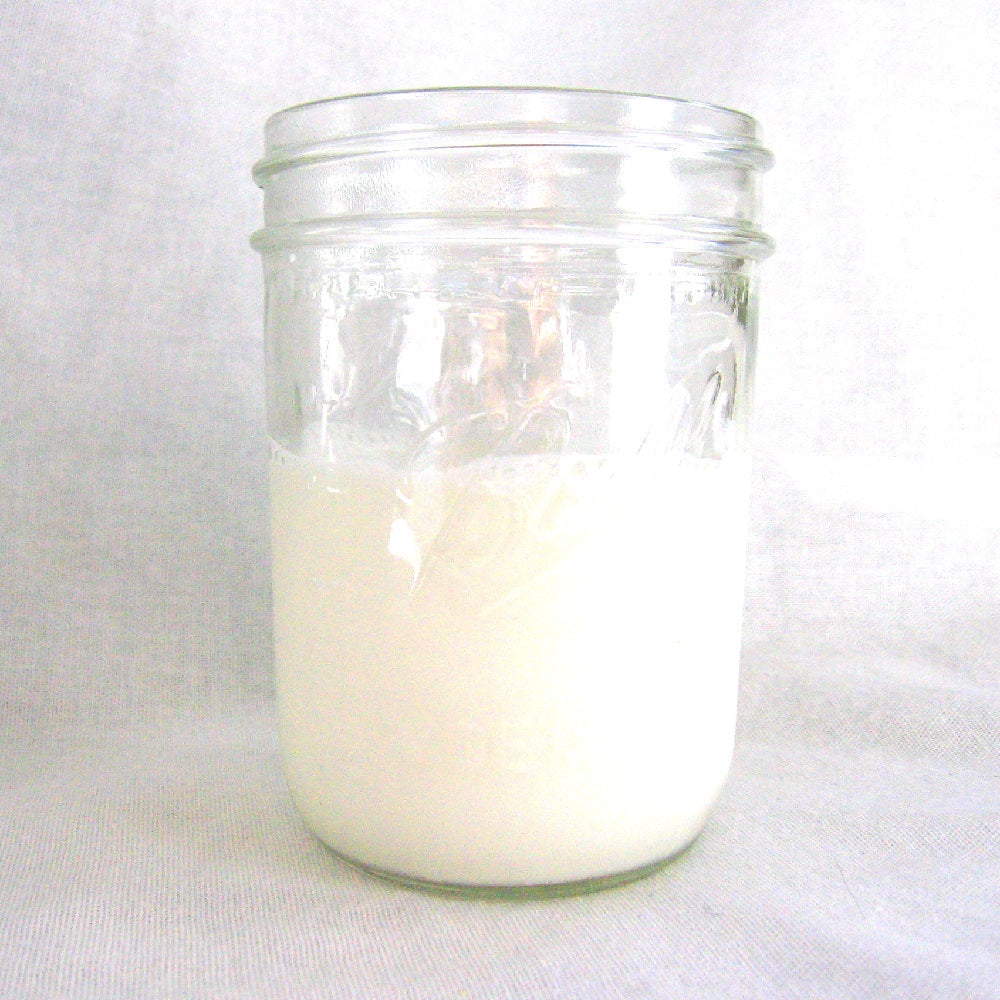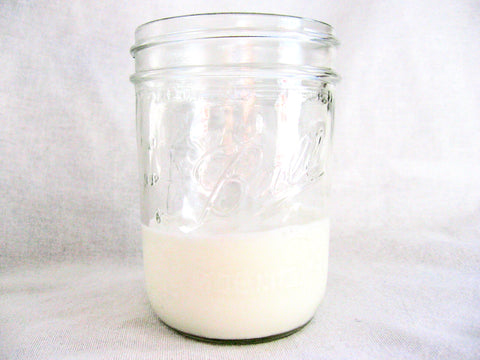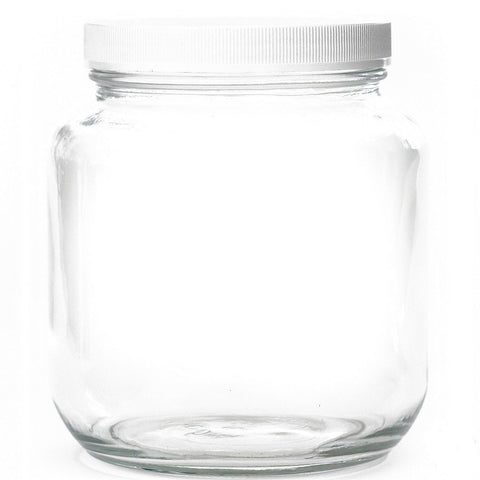
There’s a lot of discussion on how to get the best kefir.
What’s the ideal temperature? The ideal milk? The ideal duration?
Those are all important questions, but milk kefir grains are like living creatures and they will adapt to any environment if they are allowed to.
What really makes milk kefir grains happy is when they have space to get all the nourishment they need from the milk.
When you have happy grains, you get a healthy, balanced smooth kefir.
There are 3 simple requirements needed to give the grains space and make the best kefir possible:
- A high ratio of milk to grains
- Small batches or
- Wide jars
A high ratio of milk to grains

A high ratio of milk to grains simply means more milk and less grains. Starting out you may need to use 1/2 to 1 cup of milk per tablespoon of grains. But once they adapt to the new environment, 1 tablespoon can usually do about 2-4 cups.
This can vary quite a bit due to the temperature, milk, bacteria balance and space. Some grains are just naturally slow and that’s fine.
The best grains tend to make kefir slow and steady. They are bacteria rich and less yeasty. Some of the worst grains I’ve seen are those that ferment excessive amounts of milk. They are usually tiny and yeasty. This is not a good trait and your kefir is typically not as healthy or balanced.
Using more milk per the amount of grains helps the grains get all the lactose and minerals they need without harsh competition. When there’s too much competition for resources, the yeast (which is faster and more opportunistic) tends to get ahead and then you end up with yeastier grains.
Do small batches

Many people think that as long as you stick to a good ratio of grains to milk, you can easily scale up and make large quantities of milk.
Unfortunately, with milk kefir, that's not really true.
They do much better with small batches.
The reason is that milk kefir grains rise to the top during the ferment where all the grains clump together and fight for important milk resources.
So in a large batch, what you have it a ton of grains up top and a huge reservoir of milk below them which they don’t have direct access to. So they fight like crazy between themselves and some may starve a bit. When things get tough, the yeast comes in and takes over. And when grains get yeasty they rise to the top even faster. So subsequent batches will find your grains racing faster and faster to the top, becoming even more yeastier in the process. So the health continues to decline.
Not only that, the consistency of the kefir is poor due to high fermentation at the top and low fermentation at the bottom.
We always grow our milk kefir grains in small batches to prevent over-fermentation and better balance.
We have found that the grains and kefir start to suffer going above 2-3 cups of milk in a normal sized jar. Batches larger than a quart (or liter) is not recommended for optimal health.
When using a normal mason jar, we recommend about .5 to 1 tablespoon of grains to about 2-3 cups of milk for optimal kefir and happy grains. Beyond that, the quality starts to go down.
Use wide jars

If you plan to do larger batches, you need a wide jar to create smooth kefir and healthy grains.
If you do milk kefir in a skinny jar, it's just as bad as having too many grains. What happens is that when the grains rise to the top of a skinny jar, they clump on the surface and the battle royale for nutrients occurs all at the top. The top over ferments and the bottom is barely fermented.
You will know that is happening if you see pockets of whey forming at the top before the bottom of the jar.

Notice the whey forming directly under the grains. When you see that, you know you have too many grains or the jar is too skinny. The whey should always form on the bottom first.
And just like using too many grains, they become yeastier. Which actually means that they also rise to the surface even quicker (due to the carbonation by product of yeast) and then they spend even more time fighting on the surface and become yeastier. And so the grain health and kefir quality goes down.
Wider jars mean they spread out better on the surface and have better access to the milk below them. Which ultimately means a better, thicker consistency for the kefir. As well as a more balanced kefir.
With wider jars you can do larger batches if desired as well and the grains won’t suffer.
If you have a skinny jar, then 1-2 cups may be all you can do. But if you have a wide jar, you can do 3-4 cups without much issue. Maybe more if its wider.
Bottom line
The basic method to grow healthy grains and great tasting balanced kefir is space. Which means more milk and less grains. Small batches and/or wider jars.
If you are a large family or you are making kefir for others, try doing multiple small batches or find a jar as wide as possible to accommodate larger amounts of grains.
What's your perfect ratio of grains to milk? Do you use a wide jar?



Comments
Nebojsa Trajkovski
Yes its true when you are talking about the widenes of the jar and the productivity of the grains on the top and the bottom i hawe noticed it alsow. I hawe a big 5l jar and evry ferment a clump of grains on the top and none at the bottom so low productivity on the bottom. Tried to shake the kefir more frequently… same problem. Then i tryed turning the jar upside down it usualy ferments for 4-5 days in the fridge so i turn the jar every day upside down and the kefir is much better. Problem solwed ;-)
July 02, 2020
Nandarani
Put in a cool place – In Honolulu the only cool place is as night on the lanai.
Stir often. Agitate, stir and make sure all grains get into contact with the milk. When I get up for any reason at night generally go out and stir.
Use more milk. This works well with 2%, too.
All the above reduces to almost nothing the whey at the bottom! And the kefir is thickest I’ve every gotten it to be thick enough,, creamy, smooth.
It has seemed to me that Grass Fed is preferred by the grains and I prefer the taste. But emphasis on stirring is making the difference not whether using organic or organic grass fed milk..
This isn’t what I assumed before I tried it. The redistribution of grain throughout the milk is the important thing and once every 1-2 hours works as well as longer time like waiting 3 hours or so. All in all all is done by.the time a little whey, so little as to be hardly discernible, is at the bottom. This amount remains stable; it seems to ferment very very slowly.
I think the stirring makes the ferment go more slowly but more thoroughly. Less whey appears by far in the same amount of time. When I see that whey I put the entire container in the refrigerator to wait until later in the day.
This method also grows the grains.
December 17, 2019
Yemoos Nourishing Cultures
Barbyaro – Thank you for your kind words!
1. Absolutely. We’ve tried mixing some kefir into the sourdough with good results. The kefir compliments this sourdough starter and makes a moist and pleasantly sour bread. A little different flavor than pure sourdough, but still good.
It sounds like your grains are doing exactly what they are suppose to do. Keep doing whatever you are doing. Some people like fizzy milk kefir, but most do not.
2. All milk kefir grains share some strains, but there is still quite a lot of variety out there. Combining allows your grains to choose what strains work best within their matrix (and what doesn’t). With new grains, I would wait until they are balanced and strong just so you will have the best chance to combine optimally.
June 10, 2019
Barbyaro
Thank you very much for such informative help on this blog. I haven’t been through the entire site & look forward to learning more. I have 2 questions.
1. May I use kefir as part of the liquid in my gf sourdough bread or does it have a negative effect?
My kefir grains are lovely and vigorous. I get a gel like consistency at the top and grains do not seem to pile up at the top. I don’t have a fizziness to my kefir and wonder why that is described in some articles.
2. Would there be benefit to mixing grains (other probiotic strains) by seeking kefir grains from someone different than I obtained mine from?
June 10, 2019
Yemoos Nourishing Cultures
Hi Dani,
The best kefir in my opinion has a smooth gel like set which is thicker than regular milk. You will see the pockets of whey form at the bottom, not at the top. The grains should not be protruding too much above the surface either.
It’s okay to drink grainy kefir though, but its typically neither the best tasting nor the most bacteria rich.
As far as the 2nd ferment, it can vary from a couple hours to up to 24 hours. Milk kefir is so active though that we recommend doing short 2nd ferments (a couple or so hours), especially if you are adding lemon or lime peel as it can get bitter quite fast. Adding anything to a 2nd ferment tends to speed up the yeast activity and you can get a faster and stronger separation. Or you can simply do the 2nd ferment within the fridge. Add the fruit or whatever else you would like and let it sit in the fridge for a 1-2 days. It will still continue to ferment in the fridge, just at a slower rate.
If its not sour enough, too thin and separates quickly, its likely too yeasty. Less grains and/or milk milk should help. Also low fat milk will be thinner and can be hard on the grains long term.
You can use an open or closed lid. I’ve seen thick beautiful kefir done both ways.
May 05, 2019
Yemoos Nourishing Cultures
Hi Simona,
1. Yes absolutely. I’ve seen grains in terrible shape become healthy again with better ratios (more milk, less grains) and more space to get the proper nutrients. It can take several batches though. But typically you will see results within 1-2 weeks.
2. Milk kefir will continue to ferment even without the grains as the finished kefir is filled with active bacteria and yeast which will ferment the remaining milk even in the fridge. If you are getting whey on the surface instead of the bottom, then there are too many grains or the grains are too yeasty. Give them more space and they should act normal again.
May 05, 2019
Dani Burtsfield
Thank you for this very informative post! I purchased my first batch of milk kefir grains from you about a month ago and they have been growing and reproducing very well! I have a few questions…
I am curious, what does “good kefir” look like after straining the grains? How thick? If it’s as thin as the milk I put it at the beginning, is something wrong? Is it ok if it looks grainy – like what sour/spoiled milk would look like? How can I obtain creamy, thicker kefir?
My most recent batches (20 grams of grains to 2 cups of 1% non-organic milk in a 4-cup mason jar) have been very thin after straining (full 24-hour ferment) – when I go to strain them, the grains are all at the top, with about a half-inch of thick kefir on top, but runny/thin (the consistency of milk literally) underneath that. After straining, I’ve done a 2nd ferment with a small piece of lemon peel or a couple of raspberries, and it begins to separate into curds/whey within 10 minutes (the batches I made early on with full fat milk never separated on the 2nd ferment, and I left them for 12 hours). Taste-wise, it has a very mild sourness to the taste – I feel like it should be more sour, especially after a second ferment.
How long should the 2nd ferment be? I’ve read anywhere from 12 hours to no more than 1 or 2 tops.
Also, I’ve been using a screw-on plastic lid on both ferments- should I use a paper towel instead?
Thank you for your help with my questions.
May 04, 2019
Simona
Thank you very much for this post. I finally understand why my grains seemed to ferment ever faster!
My questions are:
1. can the same grains be remedied by correcting my ratios, making smaller batches in larger jars? Anything else I can do?
2.I noticed that the kefir seemed to continue fermenting even after I separated out the grains and put the ready kefir in the fridge (maybe small grains remained inside the kefir), and while initially the whey formed at the bottom of the jar, after a while it moved up and floated above the kefir. Why is that?
Thanks again,
Simona
May 04, 2019
Yemoos Nourishing Cultures
Hi Geneiveve, yes you can use canned or evaporated milk and even powdered milk. Kefir grains are hardy and willing and will ferment those milks without much issue. However, we don’t recommend it due to the extra processing involved in making those types of milks. It’s not as natural and ultimately not as healthy. With the powered milk, the cholesterol can get oxidized which is never a good thing. We recommend sticking to milks with with least amount of processing. Grass-fed or organic if possible as well.
April 30, 2019
Geneiveve
Hello,
Thank you for this forum.
My question:
Can you use any type of canned or evaporated milk to make milk kefir?
I’ve heard you can use powdered milk already made up. Is this true?
Thank you.
April 30, 2019
Leave a comment